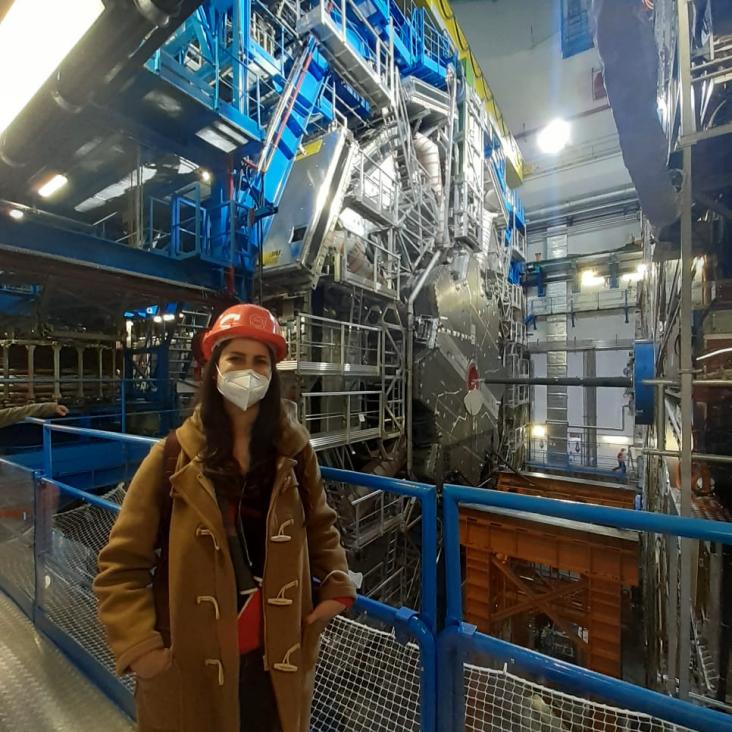Search for triple Higgs boson production in the final state using collisions at with the ATLAS detector
Physical Review D (particles, fields, gravitation, and cosmology) American Physical Society 111:3 (2025) 32006
Abstract:
<jats:p>A search for the production of three Higgs bosons (<a:math xmlns:a="http://www.w3.org/1998/Math/MathML" display="inline"><a:mi>H</a:mi><a:mi>H</a:mi><a:mi>H</a:mi></a:math>) in the <c:math xmlns:c="http://www.w3.org/1998/Math/MathML" display="inline"><c:mi>b</c:mi><c:mover accent="true"><c:mi>b</c:mi><c:mo stretchy="false">¯</c:mo></c:mover><c:mi>b</c:mi><c:mover accent="true"><c:mi>b</c:mi><c:mo stretchy="false">¯</c:mo></c:mover><c:mi>b</c:mi><c:mover accent="true"><c:mi>b</c:mi><c:mo stretchy="false">¯</c:mo></c:mover></c:math> final state is presented. The search uses <k:math xmlns:k="http://www.w3.org/1998/Math/MathML" display="inline"><k:mn>126</k:mn><k:mtext> </k:mtext><k:mtext> </k:mtext><k:msup><k:mi>fb</k:mi><k:mrow><k:mo>−</k:mo><k:mn>1</k:mn></k:mrow></k:msup></k:math> of proton-proton collision data at <m:math xmlns:m="http://www.w3.org/1998/Math/MathML" display="inline"><m:msqrt><m:mi>s</m:mi></m:msqrt><m:mo>=</m:mo><m:mn>13</m:mn><m:mtext> </m:mtext><m:mtext> </m:mtext><m:mi>TeV</m:mi></m:math> collected with the ATLAS detector at the Large Hadron Collider. The analysis targets both nonresonant and resonant production of <o:math xmlns:o="http://www.w3.org/1998/Math/MathML" display="inline"><o:mi>H</o:mi><o:mi>H</o:mi><o:mi>H</o:mi></o:math>. The resonant interpretations primarily consider a cascade decay topology of <q:math xmlns:q="http://www.w3.org/1998/Math/MathML" display="inline"><q:mi>X</q:mi><q:mo stretchy="false">→</q:mo><q:mi>S</q:mi><q:mi>H</q:mi><q:mo stretchy="false">→</q:mo><q:mi>H</q:mi><q:mi>H</q:mi><q:mi>H</q:mi></q:math> with masses of the new scalars <u:math xmlns:u="http://www.w3.org/1998/Math/MathML" display="inline"><u:mi>X</u:mi></u:math> and <w:math xmlns:w="http://www.w3.org/1998/Math/MathML" display="inline"><w:mi>S</w:mi></w:math> up to 1.5 and 1 TeV, respectively. In addition to scenarios where <y:math xmlns:y="http://www.w3.org/1998/Math/MathML" display="inline"><y:mi>S</y:mi></y:math> is off-shell, the nonresonant interpretation includes a search for Standard Model <ab:math xmlns:ab="http://www.w3.org/1998/Math/MathML" display="inline"><ab:mi>H</ab:mi><ab:mi>H</ab:mi><ab:mi>H</ab:mi></ab:math> production, with limits on the trilinear and quartic Higgs self-coupling set. No evidence for <cb:math xmlns:cb="http://www.w3.org/1998/Math/MathML" display="inline"><cb:mi>H</cb:mi><cb:mi>H</cb:mi><cb:mi>H</cb:mi></cb:math> production is observed. An upper limit of 59 fb is set, at the 95% confidence level, on the cross section for Standard Model <eb:math xmlns:eb="http://www.w3.org/1998/Math/MathML" display="inline"><eb:mi>H</eb:mi><eb:mi>H</eb:mi><eb:mi>H</eb:mi></eb:math> production.</jats:p> <jats:sec> <jats:title/> <jats:supplementary-material> <jats:permissions> <jats:copyright-statement>© 2025 CERN, for the ATLAS Collaboration</jats:copyright-statement> <jats:copyright-year>2025</jats:copyright-year> <jats:copyright-holder>CERN</jats:copyright-holder> </jats:permissions> </jats:supplementary-material> </jats:sec>Weakly supervised anomaly detection for resonant new physics in the dijet final state using proton-proton collisions at $\sqrt{s}=13$ TeV with the ATLAS detector
ArXiv 2502.0977 (2025)
Search for same-charge top-quark pair production in pp collisions at s = 13 TeV with the ATLAS detector
Journal of High Energy Physics Springer 2025:2 (2025) 84
Abstract:
A search for the production of top-quark pairs with the same electric charge (tt or tt¯) is presented. The analysis uses proton-proton collision data at s = 13 TeV, recorded by the ATLAS detector at the Large Hadron Collider, corresponding to an integrated luminosity of 140 fb−1. Events with two same-charge leptons and at least two b-tagged jets are selected. Neural networks are employed to define two selections sensitive to additional couplings beyond the Standard Model that would enhance the production rate of same-sign top-quark pairs. No significant signal is observed, leading to an upper limit on the total production cross-section of same-sign top-quark pairs of 1.6 fb at 95% confidence level. Corresponding limits on the three Wilson coefficients associated with the Otu1, OQu1, and OQu8 operators in the Standard Model Effective Field Theory framework are derived.Search for single-production of vector-like quarks decaying into Wb in the fully hadronic final state in pp collisions at s = 13 TeV with the ATLAS detector
Journal of High Energy Physics Springer 2025:2 (2025) 75
Abstract:
A search for T and Y vector-like quarks produced in proton-proton collisions at a centre-of-mass energy of 13 TeV and decaying into Wb in the fully hadronic final state is presented. The search uses 139 fb−1 of data collected by the ATLAS detector at the LHC from 2015 to 2018. The final state is characterised by a hadronically decaying W boson with large Lorentz boost and a b-tagged jet, which are used to reconstruct the invariant mass of the vector-like quark candidate. The main background is QCD multijet production, which is estimated using a data-driven method. Upon finding no significant excess in data, mass limits at 95% confidence level are obtained as a function of the global coupling parameter, κ. The observed lower limits on the masses of Y quarks with κ = 0.5 and κ = 0.7 are 2.0 TeV and 2.4 TeV, respectively. For T quarks, the observed mass limits are 1.4 TeV for κ = 0.5 and 1.9 TeV for κ = 0.7.Search for the associated production of charm quarks and a Higgs boson decaying into a photon pair with the ATLAS detector
Journal of High Energy Physics Springer 2025:2 (2025) 45


